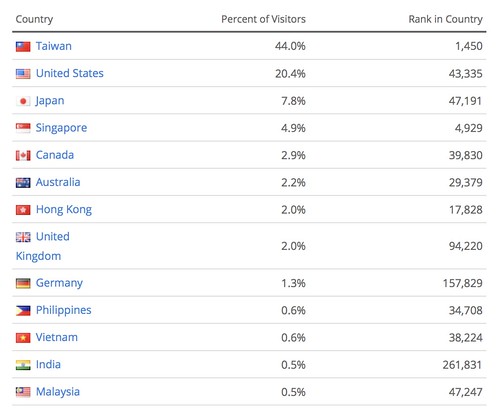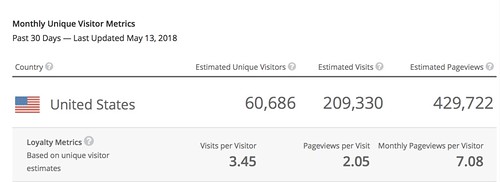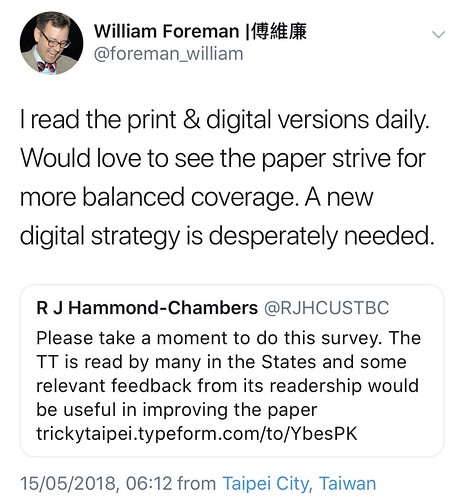A journalist in New York interviewed me for this feature article in the Taipei Times published on May 9, 2018. After buying a print copy (the first time I had done so in more than a decade), I became curious about the current state of the newspaper. I also created a survey to get a sense of who’s reading Taipei Times. If you’re interested, here are the results of that survey.
—
The Last-Standing English Print Newspaper
When Taipei Times was first published on June 15, 1999, it was Taiwan’s third English-language daily print paper. By April 17, 2017, it was the only one left. Competitors Taiwan News and China Post had already adapted — more likely, surrendered — to the digital media age. Now only Taipei Times is left, and that’s not necessarily a good thing.
Things had started off so well.
The newspaper launched with high ideals under its founding publisher Lin Rong-san [林榮三], the owner of Liberty Times Group, and Antonio Chiang [江春男], its founding editor-in-chief.
The Taipei Times’ motto: “bring Taiwan to the world and the world to Taiwan”. Its mission: “be an English-language journal of record for national and international readers, presented from a Taiwanese perspective”.
In its first year of publication, the ambitious rookie submitted an entry into the prestigious World’s Best Designed Newspaper competition judged by Society for News Design (SND). It would be named a finalist. The very next year in 2000, it would win the very highest honor in its circulation category: World’s Best Designed Newspaper.
Taipei Times went on to win awards in the Best of News Design competition for seven consecutive years until 2005. Most of them Awards of Excellence for Features Design. These accolades are still listed on the paper’s website today.
And to celebrate the paper’s 5th anniversary on June 15, 2004, a special supplement was published. It included columns reflecting on the newspaper’s birth, its ideals, its function in Taiwanese society, its struggles and successes. There was also a timeline of significant milestones.
But then Taipei Times stopped winning awards, so it stopped entering the competition altogether. I checked with SND Executive Director Stephen Komives who responded by email: “The Taipei Times has not entered the SND Best of News Design competition since 2013.”
On a similar slope of decline, Liberty Times Group and Taipei Times did nothing to celebrate the paper’s 10th anniversary in 2009. Nothing for the 15th anniversary in 2014 either.
I tried to contact the chief editor but failed. After sending my questions to the “Letters to the Editor” inbox (no response), I called the chief editor’s assistant twice — but wasn’t put through.
Today, I received a response from the assistant in Chinese: “The chief editor is traveling. A supervisor says to inform you since the newspaper receives many inquiries, we cannot answer all of these questions. Thank you for your support of Taipei Times. We wish you the best.”
The only information I found about print circulation came from a previous version of the website’s About Us page. It stated: “As of October 2002, the Taipei Times has recorded a daily circulation of 280,000 copies”. That passage appeared on the website until October 2010 when it was removed.
With that, I guess we can assume Liberty Times Group doesn’t share circulation figures publicly, and hasn’t done so for more than 15 years.
—
Disregard for the Digital Reader
While Taipei Times has existed in a Groundhog Day-like vacuum, the English-language media landscape in Asia has seen a whirlwind of change these past years.
In July 2015, The Straits Times of Singapore launched a redesign of their brand identity and website for its 170th anniversary. The goal: to serve readers better. The print and digital overhaul won various global design awards.
In March 2017, The Japan Times celebrated its 120th anniversary with a redo of its logo, print paper and digital platforms. The process took years of preparation, research, discussion and work by their internal design team.
In February 2018, it would be South China Morning Post‘s turn. The 115-year-old paper revealed upgraded offices in Hong Kong and introduced a new identity with its own branded microsite: news.scmp.com.
Taipei Times turns just 19 years old on June 15, 2018 yet it looks more tired than all three of these centenarian newspapers. And while they have live news apps for iOS and Android, the Taipei Times site is still not mobile-friendly in 2018. Go take a squint at taipeitimes.com on your phone.
So yeah, let’s talk about the website.
Taipeitimes.com went live on August 31, 1999. It was redesigned in late-2002. Then changed slightly in late-2003. The site you see today launched around September/October 2010.
I went through the painful task of mining through the Wayback Machine to find and capture each version. I would say “enjoy” but in all honesty I don’t think anybody will.


Above is the original design from 1999. The reason it looks clean is there’s no advertising.


This is the redesign of late-2002. The width is fixed leaving dead space on both sides. Ads start to make their appearance.


A year later in late-2003, the width was stretched back out. Then in April 2004, an About Us page was added to the left-side column.


Between September 19 and October 3, 2010, the current version goes live. Yes, we are back to the fixed width. Even by 2010 standards the design is extremely dated.


Save for some very minor tweaks, the site is more or less the same today. Above is the homepage on May 12, 2018. The text on the About Us page has not been updated since 2010.
How did things get so bad? It’s like a lifelong hoarder looking into their messed-up home and saying, “Whoa, it seemed fine just a while ago.”
Also, I don’t know how relevant this is, but it must be said:
The lack of investment in Taipei Times’ digital platforms is not for lack of cashflow. The founder of Liberty Times Group, Lin Rong-san [林榮三] was listed by Forbes as the 9th richest person in Taiwan. He had a fortune valued at US$3.9 billion when he passed away in November 2015.
—
Despite All This, Still Taiwan’s Flagship
Like it or not, Taipei Times remains without question Taiwan’s most influential English-language newspaper representing Taiwan on the global stage.
The print version is inextricably linked to our city’s sense of place. People post photos of the front page on Instagram to say, “I’m in Taipei.” They buy copies as souvenirs to commemorate major social and political events.
It also represents an international mindset. The belief that Taipei has something worthwhile to say to the rest of the world. That we have a voice in global conversations. Perhaps we’re not so isolated.
The digital version, it pains me to say, bears an even bigger burden. It’s where the world clicks to see evidence of Taiwan’s freedom of the press — ranked the highest in East Asia — and our democracy in action.
I believe this status has less to do with how the Liberty Times Group runs Taipei Times, and more to do with how others view it.
For instance, when 12 government representative offices in Taiwan joined together last week to endorse this remarkable op-ed in support of marriage equality in Taiwan, they chose to publish the English version in the Taipei Times. The Chinese version was released by Next Media. Maxime Ramon, Deputy Director of the Belgian Office Taipei, said the “objective was to have as large coverage as possible in both Mandarin and English”.
And when I tweeted an online survey on May 13th to collect data about Taipei Times’ readership, two notable people chimed in.
On May 14, Rupert J Hammond-Chambers (@RJHCUSTBC), president of the US-Taiwan Business Council based in Washington DC, shared the survey link with this note.
The next day, William Foreman (@foreman_william), president of the American Chamber of Commerce in Taipei (AmCham Taipei), retweeted Hammond-Chambers with his own comment.
To understand how far taipeitimes.com reaches, I used Alexa to collect estimated figures for global readership. For the 30 days up to May 13, Alexa reported these top countries:


And these estimates for US readers, specifically.


From these estimates, we can extrapolate the site receives at least 300K total unique visitors every month, or 3.6 million unique visitors a year. (If the US estimate of 60K unique visitors per month represents 20% of total audience.)
That’s more than 2 million people around the world (minus Taiwan’s own 40% share) who log onto the site as their window into Taiwan.
Imagine how many more would be reading if social media could work its magic? If the site was mobile-friendly? If the website was designed for readability?
—
Can the Taipei Times Be Saved?
Let’s be realistic. There’s a very good chance the newspaper will sleepwalk through its own 20th anniversary next year. And unfortunately, the problems associated with running English-language media in Taiwan are long-standing. (See this Taiwan Today article from August 2006 for an overview.) I doubt things have changed much.
However, I don’t want to believe it’s too late. I hope the Taipei Times can be saved.
To have a fighting chance, the digital platforms would have to be rebuilt from scratch. They’d need to hire a small and tech-savvy digital media team immediately. Of course, it also wouldn’t hurt to invest in a brand redesign — including a new logo — that looks good everywhere. See evidence of how wonky the logo looks on the Taipei Times Instagram account.
But before all that can happen, the management at Liberty Times Group must be open and willing to listen to what their readers have to say. And they need leaders at Taipei Times to step up and take on this challenge.
To get the ball rolling, I’ve collected more than 100 responses in this survey of Taipei Times readers. Let’s take a look.






I worked at the TT as a copy editor from 1998-2006. While the original managing editor (Anthony Lawrence of South Africa) was competent and somewhat tolerable, he quit after discovering that the Taiwanese management wanted to make the paper a mouthpiece for the DPP, while thinly disguising the paper as a reliable news source. His deputy, Lawrence Eyton, was awarded the managing editor position. One could say that the TT began it’s downward slide from the beginning. Eyton turned the TT into a toxic environment and was finally fired in 2005.
Don’t bother sending anything to the “Letters to the Editor” address if it relates to Taiwan’s domestic issues. If your writing fails to fall into complete lock-step with their rigid, weirdly nanny-stateish social-engineering collectivist DPP-authorized agenda, there is no chance they will acknowledge it, let alone print it.
Such a pity both the DPP and the Taipei Times are not open-minded enough to realize that Taiwan’s laissez-faire society is its greatest strength.
Both they and the DPP need to realize no-one wants to live in a sterile, controlled, dystopian society like Singapore, which seems to be the current administration’s ultimate, misguided goal. KMT will be voted back into power if the arrogant, meddling DPP urban elitists do not realize and fix this overreach and start taking a more liberty-minded hands-off attitude, in harmony with Taiwanese people’s national character.
While reading your article, I was wondering: why is it called Taipei Times and not Taiwan Times?
Regarding the newspaper itself, I recommend reading J. Michael Cole’s “Officially Unofficial: Confessions of a Journalist in Taiwan”. It was published in 2014 and gives a pretty good insider point of view (Cole worked for the Taipei Times).
I would read Taipei Times again if it invested in serious journalism and tried to be a little bit more objective, but that requires them to invest in their staff, which apparently is impossible to do.
I buy and read the Taipei Times every day and have done since it first started 20 years ago. It’s a great paper I hope it does not go down.
The TT’s problems are far more serious than website or logo design. It’s the uncritical import of left wing, political correctness on nearly all subjects without any balance and the lack of budget for serious journalism. The constant errors and editorial howlers don’t help either.
You should do a piece on how to fix Forumosa next.
I buy the print edition several times a week and enjoy the Taiwan focused news. I also use it every Saturday in the classroom, especially its great Feature page.